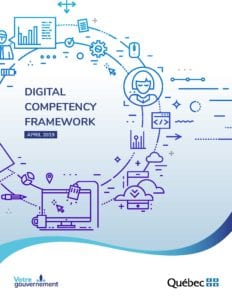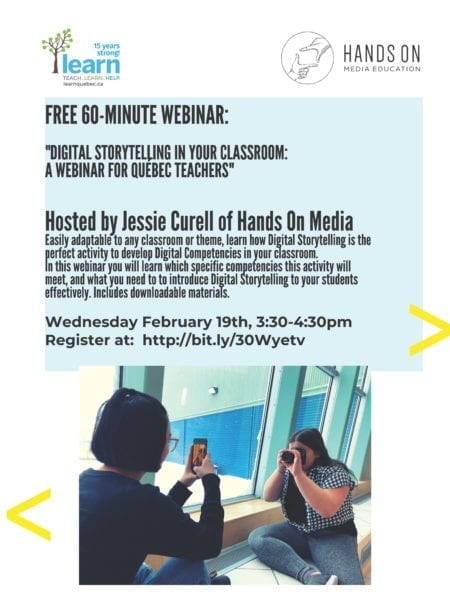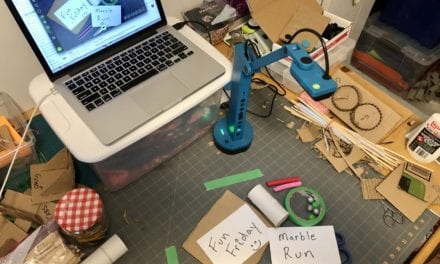
Graphic representation by Jennie Vandermeer
This is a guest post for our blog by Jessie Curell, the Founder of Hands On Media Education.
In this age of ever-increasing digital communication, creation, and connection, it is more critical than ever that we teach our youth the importance of safe, responsible, and creative digital habits and skills to ensure their success in the 21st century.
As we know, Québec’s Ministry of Education has recently introduced the Digital Competency Framework for both students and teachers to support the development of these skills in our school system. LEARN has created a website to help guide teachers new to the Digital Action Plan for Education. As critical as these twelve competencies are, I regularly hear from teachers that they need help in implementing these new objectives, both as educators, and in their classrooms. Effective and easy-to-follow professional development training and resources are required – which is why I started Hands On Media Education.
 For the past fifteen years, I have worked with hundreds of teachers in Quebec, Ontario, British Columbia, and the Northwest Territories, delivering Digital Storytelling workshops as a powerful hands-on Digital Literacy activity for students of all ages.
For the past fifteen years, I have worked with hundreds of teachers in Quebec, Ontario, British Columbia, and the Northwest Territories, delivering Digital Storytelling workshops as a powerful hands-on Digital Literacy activity for students of all ages.
The format of a Digital Story is a personal or team-based digital media project, using a combination of voice, still images, music, and text to tell a point of view, opinion, life story, or message. Once a project is complete, students and educators are encouraged to share their project online, whether that be on their school website, a private Youtube channel, their teachers’ Facebook group, or their own personal social media platform.
Our Digital Storytelling activity helps foster critical skills around each of the Quebec Digital Competency Dimensions, as listed below:
| # | Digital Competency Dimension | Element of Digital Storytelling Workshop |
|---|---|---|
| 1 | Exercising ethical citizenship in the digital age | In this workshop, we discuss consent and permission when using photographs and music for our projects |
| 2 | Developing and mobilizing technological skills | Learning how to create our own media using digital tools is keeping one’s digital skills up to date |
| 3 | Harnessing the potential of digital resources for learning | We encourage students to use the internet to research their subject, as well as to find copyright-free images |
| 4 | Developing the ‘mobilizing information’ literacy | When using the internet for research purposes, we teach basic critical thinking and information verification skills |
| 5 | Collaborating via digital technology | We encourage students to host a community screening of their finished projects, bringing in community members together through digital means |
| 6 | Communicating via digital technology | The creation process requires effective and accurate communication of one’s message and idea through digital tools |
| 7 | Producing content via digital technology | The bulk of this workshop is focused on empowering the student through the creation of digital media using digital technology |
| 8 | Using digital tools to foster inclusion and address diverse needs | By asking each student to share their own perspective, the audience, teacher, and fellow students are able to understand and empathize on a much deeper level with each student |
| 9 | Mobilizing digital technology for personal and professional empowerment | By teaching important Digital Literacy skills, we are helping prepare each student for the digital world during and after their school career |
| 10 | Solving problems via digital technology | We often ask students to describe an issue in their community that affects them, and how they can get involved. By sharing their Digital Story online, they can raise awareness about said issue for change. (ex: climate change) |
| 11 | Developing critical thinking with regard to the use of digital technology | There is no better way to develop media literacy and critical skills than to create your own media project, thereby understanding how all media are constructions. |
| 12 | Adopting an innovative and creative approach to the use of digital technology | Through this activity, we are using digital tools to express our creativity and to encourage others to do the same |
 Considered by many to be an introductory documentary video project, the advantage of beginning with a Digital Story lies in the simplicity of the required technology. With a simple phone or iPad camera, and with free or inexpensive editing software (iMovie for iPhone or iPad and Filmora for PC), the technical difficulties and obstacles for teachers and students alike are low which allow for a greater emphasis placed on the reflection, story, and message.
Considered by many to be an introductory documentary video project, the advantage of beginning with a Digital Story lies in the simplicity of the required technology. With a simple phone or iPad camera, and with free or inexpensive editing software (iMovie for iPhone or iPad and Filmora for PC), the technical difficulties and obstacles for teachers and students alike are low which allow for a greater emphasis placed on the reflection, story, and message.
Sharing our perspectives, opinions, and ideas with the world through screenings and online (maybe on your school website!) can also be very empowering experiences, which can lead to greater confidence, knowledge, and skill development for each student.
Creating Digital Stories in a safe and encouraging environment is an empowering form of creative expression that allows creators to practice traditional literacy activities through storytelling. See an example from NWT Grade 10 teacher Gene Jenks here.
After meeting thousands of teachers across Quebec and Canada, I know how hard it can be to teach Digital Literacy for the first time. A lack of confidence, training or basic technology can hold educators back from embarking on their first Digital Literacy activity. Educators can sometimes embrace their non-expertise and model to students how to approach a project when you aren’t familiar or adept with the technology involved. Other times, a learning community or a workshop can make the learning curve less steep.
 I also deliver Digital Storytelling workshops to many Indigenous communities, involving the youth, adults, and elders. Topics for their projects include: a typical day in their life, dreams for what they wanted to do when they great up, advice they have for other youth, and what makes them proud to be Indigenous. See an example from NWT youth Jaryd McDonald here.
I also deliver Digital Storytelling workshops to many Indigenous communities, involving the youth, adults, and elders. Topics for their projects include: a typical day in their life, dreams for what they wanted to do when they great up, advice they have for other youth, and what makes them proud to be Indigenous. See an example from NWT youth Jaryd McDonald here.
Between vlogs, social media, livestreaming, and other digital media platforms becoming increasingly popular among the younger generations, there is an appetite among students to become creative producers of media content that speaks to their experiences and their worldview. Educators have an opportunity to help them develop their voice.
 If you want to learn more about integrating digital storytelling into your classroom and community, join Hands on Media Education and LEARN for “Digital Storytelling in the Classroom: A Webinar for Québec Teachers” on Wednesday, February 19th from 3:30-4:30 PM. To register, simply complete this short form.
If you want to learn more about integrating digital storytelling into your classroom and community, join Hands on Media Education and LEARN for “Digital Storytelling in the Classroom: A Webinar for Québec Teachers” on Wednesday, February 19th from 3:30-4:30 PM. To register, simply complete this short form.
 Jessie Curell is a Digital Media Literacy advocate and Founder of Hands on Media Education. She is dedicated to empowering educators, youth, teams, and nations with the skills to thrive in the digital world. With over 15 years of field experience building strategies and programs for students, educational institutions, and professionals, Jessie is always looking for new ways to facilitate the creation of digital projects in fun, responsible ways.
Jessie Curell is a Digital Media Literacy advocate and Founder of Hands on Media Education. She is dedicated to empowering educators, youth, teams, and nations with the skills to thrive in the digital world. With over 15 years of field experience building strategies and programs for students, educational institutions, and professionals, Jessie is always looking for new ways to facilitate the creation of digital projects in fun, responsible ways.




